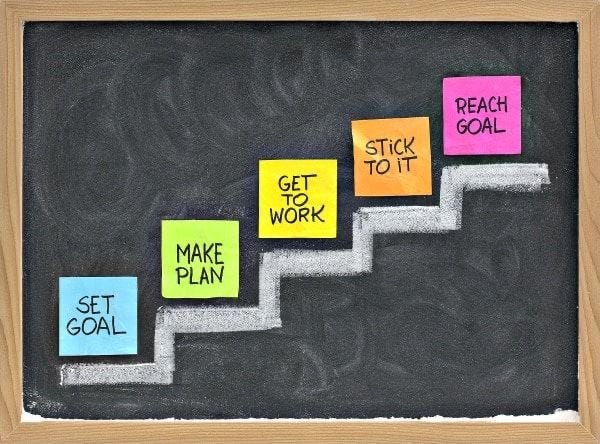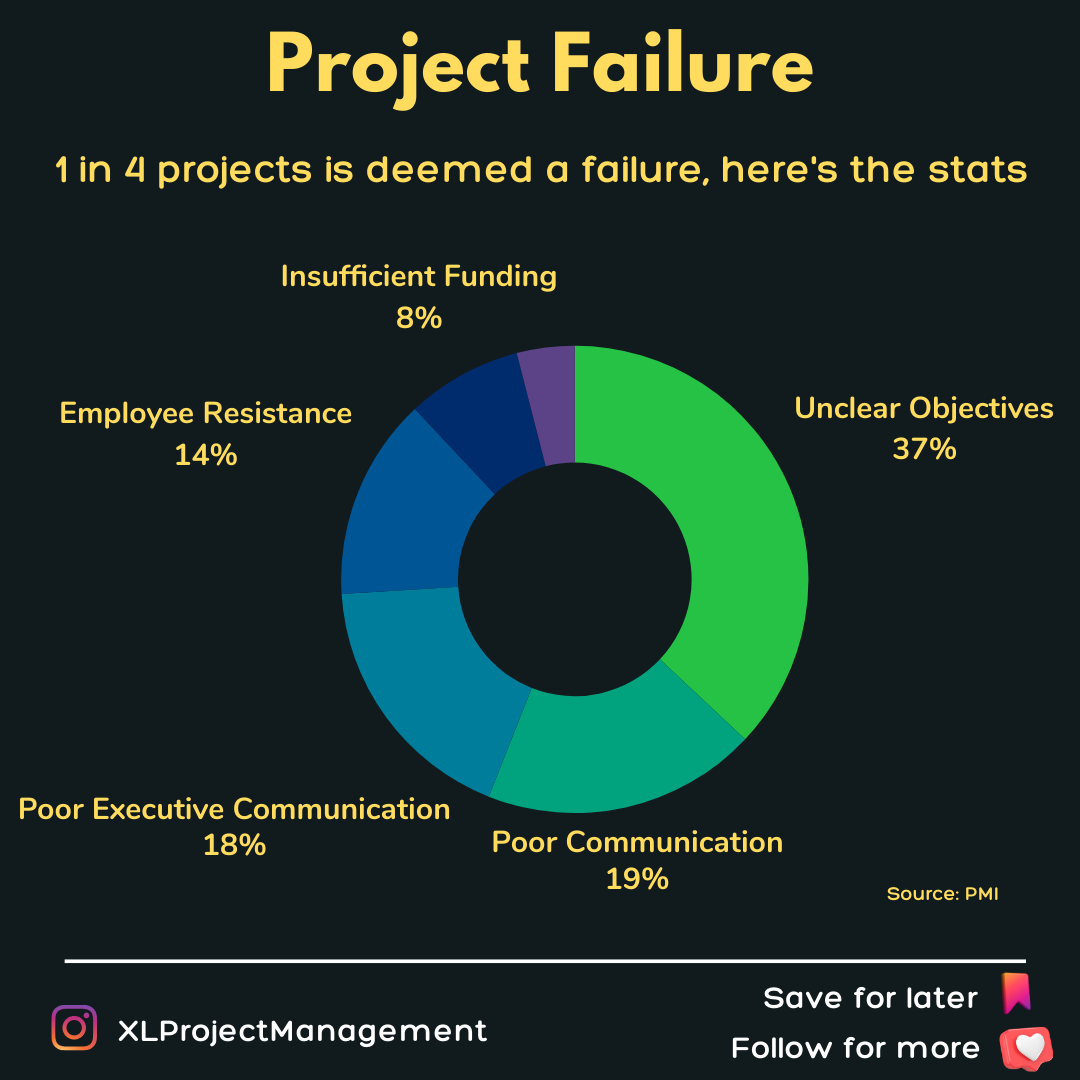Today at a Glance:
🚪 Intro - The Newsletter is back
🚀 Quote of the Week
❔ Community Question Answered
⛔ Why Projects Fail - How to overcome the statistic
The Newsletter is back!
Hey Guys!
It’s been some time since the last newsletter, but I have had a lot of requests to reinstate it along with other content…so here we are!
To be honest, I have taken some time out to reflect on what other value myself and XL Project Management can add to the continually growing community.
In addition to the Instagram page, you will start to see a bit more on other platforms, but those subscribing to the newsletter will hear about it first and get exclusive extra content to support your growth and development towards your career and business goals!
Quote of the week
“The major reason for setting a goal is for what it makes of you to accomplish it. What it makes of you will always be the far greater value than what you get.” - Jim Rohn
Yours Questions
Great question! The key term here is consistently, it is easy to manage stakeholder’s expectations at the start, but consistently you will need the right foundations.
By foundations, I mean processes and a drum beat which could include:
Scheduled period progress meetings
Meeting minutes
Clear metrics that lead to project success
Understanding what their expectations are
Another top tip is to leverage the power of a RACI matrix and/or communication plan (depending on the complexity and size of the project).
A RACI matrix will provide stakeholders with the platform for them to say where they want to be consulted or informed on activities.
A communication plan will provide a good idea of what and how often stakeholders want to receive information. Some may go as far as specifying the format in which they may want to receive the information.
Drop a comment below on how you have managed stakeholders:
Why Do Projects Fail?
Ever found yourself knee-deep in a project, surrounded by chaos, wondering where it all went wrong? I got you! According to the Project Management Institute (PMI), a whopping 37% of project failures can be blamed on one common issue: unclear objectives.
If you've been managing projects for a while, you know how crucial it is to set clear, achievable objectives right from the start. They act as your team's North Star, guiding them towards success and ensuring everyone stays focused on the project's main goals. But with all the deadlines and tasks flying around, it's easy for objectives to get lost in the shuffle.
Unclear Objectives create a domino effect of confusion and miscommunication throughout the project's life cycle. Team members might feel unsure about their roles or what the project's priorities are, leading to inefficiency and frustration.
I can’t stress enough that if you don’t start your project correctly, it’s like a ship heading for a crash 🚢💥! How do you know where to aim for if you don’t have a clear view of the final destination or what it looks like?
Here’s a question I received recently from:
I’ve been here too, here is what I would recommend to troubleshoot the situation:
Do you have a Project Scope Document or equivalent? If Yes, great - convert it into a SMART template.
If the answer to 1) is No - start engaging with your key stakeholders (Project Owner and Project Sponsor at a minimum) to put something SMART-related down on paper that they can sign off on.
Once you have this, communicate it to the team so it is clear where the project is heading.
What is the solution to this, you say!?
The key strategies you can use are:
SMART / CLEAR goals 🎯 (I’m going to focus on this in the newsletter)
Engage with stakeholders 💬
Use Visual Tools 👀
STRATEGICALLY DEVELOP YOUR GOALS
By taking the time to clearly define measurable objectives at the beginning of a project, you're building a strong foundation for success. These objectives should be specific, achievable, relevant, and time-bound (SMART), giving your team a clear roadmap to follow.
Communication is crucial to ensure everyone understands the project objectives. Regular check-ins, updates, and open discussions can help clear up any confusion and keep the project on course. Remember, a well-informed team is a confident team.
So, before getting started on your next project, take a moment to review the objectives. Are they crystal clear, or could they use some tweaking? Investing time upfront to clarify objectives could save you a lot of headaches later on.
Here are some previous posts I have done on CLEAR and SMART goals.
I have a really simple template you can start using TODAY to start mapping out those goals, by answering some straightforward questions for yourself and the team.
Setting out SMART goals is not always the easiest to grasp at first, but the main point that has stood out for me is to remember is to ensure they are MEASURABLE 📏.
Check out this link for a template with some pertaining questions to ask yourself when developing your goals with your stakeholders, get it here 👉 SMART GOAL TEMPLATE.
The Benefits of SMART Goals
🎯 Enhanced Clarity and Focus: By requiring specific and measurable objectives, these frameworks eliminate ambiguity and help individuals and teams focus their efforts on what is most important.
🔗 Increased Accountability: Clear benchmarks for success and explicit timelines hold all parties accountable, fostering a sense of ownership and responsibility.
⚙️ Improved Productivity: With clearly defined goals, resources can be allocated more efficiently, and distractions minimized, leading to better productivity and streamlined processes.
🤝 Enhanced Collaboration: Goals set using the CLEAR methodology are inherently collaborative, encouraging teamwork and improving communication as team members work towards a common objective.
🔄 Flexibility and Adaptability: The refinable aspect of CLEAR goals allows for adjustments in response to changing circumstances, promoting adaptability and continuous improvement.
Challenges Associated with SMART/CLEAR Goals
📊 Overemphasis on Measurable Outcomes: SMART goals can sometimes lead to an overemphasis on quantifiable results at the expense of qualitative outcomes, which can be equally important.
⏳ Complexity and Time Consumption: The process of setting comprehensive SMART/CLEAR goals can be time-consuming and complex, potentially slowing down initial project momentum.
🔒 Inflexibility: Particularly with SMART goals, the need for specific and time-bound targets can lead to rigidity, making it difficult to adapt to unforeseen changes or innovative opportunities.
🧩 Dependency on Initial Information: Both frameworks depend heavily on the accuracy and completeness of the information available at the time the goals are set. Inaccurate initial assessments can lead to goals that are either too challenging or too easily achieved.
🎨 Potential Decrease in Creativity: The structured nature of these goal-setting frameworks might constrain thinking and discourage creative approaches to problem-solving.
If you have more specific questions, drop me a message below:







